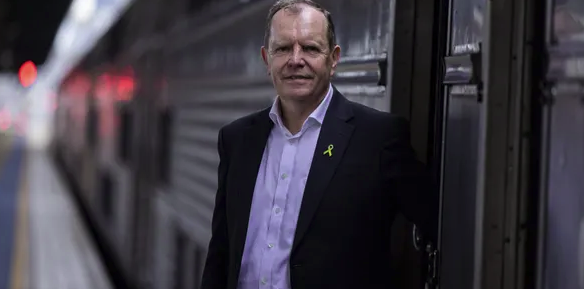Given high-speed rail’s much mocked history of failed starts in Australia, Tim Parker manages to appear optimistic, even excited, about the decades-long project he has been tasked with delivering.
Parker, a former senior executive at Sydney Metro, was in January appointed inaugural chief executive of the High Speed Rail Authority (HSRA) – the body established to carry out Labor’s 2022 election commitment to build the rail line along the east coast.
Progress has been anything but high speed. It took until June 2023 for the authority to be created, while work on a business case for the initial Sydney-Newcastle section has only just begun.
But Parker – a British transport and infrastructure specialist who has also worked in Hong Kong – paints a colourful picture of his vision for high-speed rail.
For starters, he has much more detail – such as news of tenders being awarded – about the project than his interim predecessor, whose appearance at a Senate estimates hearing in October laid bare the project’s glacial pace and drew comparisons to Utopia, a TV series satirising the absurdity of government bureaucracy.
Parker has prepared himself for when his organisation is compared to one of the best known episodes in that series about this very issue.
“The way around [Utopia comparisons] is to just deliver, but also to get some excitement back.
“I don’t need to talk about nation building or anything, because this is a fundamental project that could change so many people’s lives for the better … it’s not just making your commute quicker, it’s about moving settlement patterns and creating prosperous cities.”
Grand stations, onboard internet, good coffee and pets are just some of the things Parker wants to see in a bullet train future for Australia.
Building on previous studies
Parker’s authority has a head start thanks to a wealth of existing feasibility studies.
He says a federal government study from 2013 for a line between Melbourneand Brisbane forms the basis of the HSRA’s early plans.
The most recent proposal for high-speed trains between Sydney and Newcastle – the New South Wales government’s “fast rail” plan to go it alone without federal help, unveiled by then premier Gladys Berejiklian before the 2019 state election – will also shape the planning.
Four years after the push for 250km per hour trains on the corridor began, and with roughly $100m spent on feasibility studies, Guardian Australia revealed the Perrottet government quietly abandoned the plan, abruptly halting work on a final business case just as geotechnical drilling was being finalised. The Minns Labor government officially “descoped” the project when it came to power in 2023. No corridor was preserved.
Transport advocates and business groups blasted what they saw as the wastefulness of yet another addition to the graveyard of bullet train studies, but Parker says 24 of the Transport for NSW staff who worked on the state plan have been seconded to the HSRA. He hopes to have a team of about 100 by the end of the year.
“Let’s not throw that stuff away,” Parker says of the NSW plan. “What we’re trying to do is not reinvent the wheel. The reality is, there’s been a lot of work done already; part of our task now is to harness that work.”
The HSRA must deliver a business case and a product definition report for the Brisbane-Melbourne line by the end of the year, funded by $78.8m from the commonwealth.
Land that needs to be preserved to provide a corridor in and out of cities will be recommended in the report. While it’s a tight timeframe, Parker believes it’s possible “because we’re not starting from scratch”.
“There’s people on board who have been looking at this for a number of years,” he says.
The authority is yet to determine the exact route and location of stations, but Parker holds two strong views.
One is that an entirely new, dedicated track should be built instead of upgrading existing lines, such as the proposal that would reduce the existing 11-hour Sydney-Melbourne trip to six hours with minor works. “Those railways are very busy. The Sydney to Newcastle track has 15 million people a year using it. Imagine saying ‘Can I take it out for a couple of months?’,” he says.
His other firm belief is that high-speed services should travel into city centres – a nod to calls for previous projects to build a Sydney station at Olympic Park to avoid logistical headaches.
“I look around the world where all the good high-speed [trains] go, they don’t put the stations out of the way. We don’t have to sacrifice convenience just to make it easy to build,” he says.
Having familiarised himself with Sydney’s Central station during his time on the city’s metro project, he points to the stone wall in a newly opened area, pointing to deliberately manufactured soft spots that can be easily broken through to build a tunnel to a high-speed platform.
“Think of some of the world’s greatest stations, St Pancras [in London], Gare du Nord [Paris]. [Sydney’s Central] has got the makings of a great station,” he says.
The Guardian



